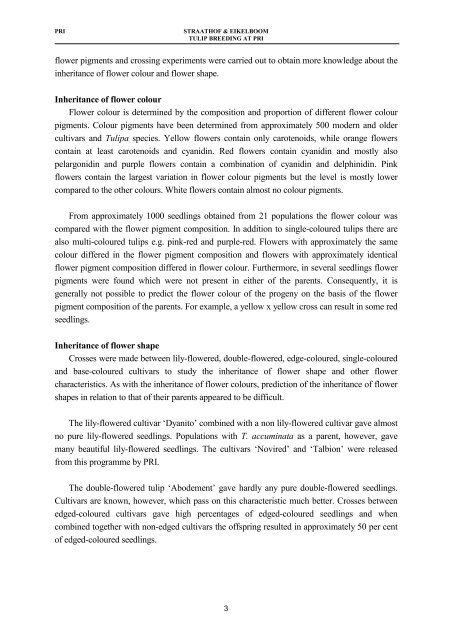Tulip breeding at PRI - The Lilium information page
Tulip breeding at PRI - The Lilium information page
Tulip breeding at PRI - The Lilium information page
Create successful ePaper yourself
Turn your PDF publications into a flip-book with our unique Google optimized e-Paper software.
<strong>PRI</strong><br />
STRAATHOF & EIKELBOOM<br />
TULIP BREEDING AT <strong>PRI</strong><br />
flower pigments and crossing experiments were carried out to obtain more knowledge about the<br />
inheritance of flower colour and flower shape.<br />
Inheritance of flower colour<br />
Flower colour is determined by the composition and proportion of different flower colour<br />
pigments. Colour pigments have been determined from approxim<strong>at</strong>ely 500 modern and older<br />
cultivars and <strong>Tulip</strong>a species. Yellow flowers contain only carotenoids, while orange flowers<br />
contain <strong>at</strong> least carotenoids and cyanidin. Red flowers contain cyanidin and mostly also<br />
pelargonidin and purple flowers contain a combin<strong>at</strong>ion of cyanidin and delphinidin. Pink<br />
flowers contain the largest vari<strong>at</strong>ion in flower colour pigments but the level is mostly lower<br />
compared to the other colours. White flowers contain almost no colour pigments.<br />
From approxim<strong>at</strong>ely 1000 seedlings obtained from 21 popul<strong>at</strong>ions the flower colour was<br />
compared with the flower pigment composition. In addition to single-coloured tulips there are<br />
also multi-coloured tulips e.g. pink-red and purple-red. Flowers with approxim<strong>at</strong>ely the same<br />
colour differed in the flower pigment composition and flowers with approxim<strong>at</strong>ely identical<br />
flower pigment composition differed in flower colour. Furthermore, in several seedlings flower<br />
pigments were found which were not present in either of the parents. Consequently, it is<br />
generally not possible to predict the flower colour of the progeny on the basis of the flower<br />
pigment composition of the parents. For example, a yellow x yellow cross can result in some red<br />
seedlings.<br />
Inheritance of flower shape<br />
Crosses were made between lily-flowered, double-flowered, edge-coloured, single-coloured<br />
and base-coloured cultivars to study the inheritance of flower shape and other flower<br />
characteristics. As with the inheritance of flower colours, prediction of the inheritance of flower<br />
shapes in rel<strong>at</strong>ion to th<strong>at</strong> of their parents appeared to be difficult.<br />
<strong>The</strong> lily-flowered cultivar ‘Dyanito’ combined with a non lily-flowered cultivar gave almost<br />
no pure lily-flowered seedlings. Popul<strong>at</strong>ions with T. accumin<strong>at</strong>a as a parent, however, gave<br />
many beautiful lily-flowered seedlings. <strong>The</strong> cultivars ‘Novired’ and ‘Talbion’ were released<br />
from this programme by <strong>PRI</strong>.<br />
<strong>The</strong> double-flowered tulip ‘Abodement’ gave hardly any pure double-flowered seedlings.<br />
Cultivars are known, however, which pass on this characteristic much better. Crosses between<br />
edged-coloured cultivars gave high percentages of edged-coloured seedlings and when<br />
combined together with non-edged cultivars the offspring resulted in approxim<strong>at</strong>ely 50 per cent<br />
of edged-coloured seedlings.<br />
3














